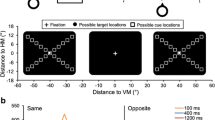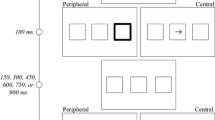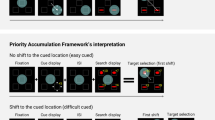Abstract
When the interval between a non-predictive cue and a target appearing at the same spatial location is longer than about 200 ms, target performance is typically poorer than when the cue and target appear at different locations. Recent studies have shown that this effect, known as inhibition of return (IOR), can occur at multiple cued locations, and is enhanced when multiple cues are presented at the same spatial location. However, little is known about how the magnitude of IOR at one spatial location is influenced by a subsequent or preceding cue presented at a different spatial location. We investigated this issue by presenting single or multiple cues at varying inter-cue intervals prior to target onset. Results suggest that the magnitude of IOR at a given location is influenced by the presentation of a preceding cue, but that once IOR occurs, it is unaffected by the presentation of a subsequent cue.

Similar content being viewed by others
Notes
We thank Raymond Klein and Kristie Dukewich for pointing out this possibility.
References
Bennett, P. J., & Pratt, J. (2001). The spatial distribution of inhibition of return. Psychological Science, 12(1), 76–80.
Birmingham, E., & Pratt, J. (2005). Examining inhibition of return with onset and offset cues in the multiple-cuing paradigm. Acta Psychologica, 118, 101–121.
Birmingham, E., Visser, T. A. W., Snyder, J. J., & Kingstone, A. (2007). Inhibition of return: Unraveling a paradox. Psychological Bulletin & Review, 14, 957–963.
Danziger, S., Kingstone, A., & Snyder, J. J. (1998). Inhibition of return to successfully stimulated locations in a sequential visual search paradigm. Journal of Experimental Psychology: Human Perception and Performance, 24, 1467–1475.
Dodd, M. D., Castel, A. D., & Pratt, J. (2003). Inhibition of return with rapid serial shifts of attention: Implications for memory and visual search. Perception & Psychophysics, 65, 1126–1135.
Dukewich, K. R. (2009). Reconceptualizing inhibition of return as habituation of the orienting response. Psychonomic Bulletin & Review, 16, 238–251.
Dukewich, K. R., & Boehnke, S. E. (2008). Cue repetition increases inhibition of return. Neuroscience Letters, 448, 231–235.
Faul, F., Erdfelder, E., Lang, A.-G., & Buchner, A. (2007). G*Power 3: A flexible statistical power analysis for the social, behavioral, and biomedical sciences. Behavior Research Methods, 39, 175–191.
Gabay, S., & Henik, A. (2008). The effects of expectancy on inhibition of return. Cognition, 106, 1478–1486.
Gabay, S., & Henik, A. (2010). Temporal expectancy modulates inhibition of return in a discrimination task. Psychonomic Bulletin & Review, 17, 47–51.
Ivanoff, J., & Klein, R. M. (2001). The presence of a nonresponding effector increases inhibition of return. Psychonomic Bulletin & Review, 8, 307–314.
Ivanoff, J., & Klein, R. M. (2004). Stimulus-response probability and inhibition of return. Psychonomic Bulletin & Review, 11, 542–550.
Klein, R. M. (1994). Perceptual motor expectancies interact with covert visual orienting under conditions of endogenous but not exogenous control. Canadian Journal of Experimental Psychology, 48(2), 167–181.
Klein, R. M. (2000). Inhibition of return. Trends in Cognitive Sciences, 4(4), 138–147.
Klein, R. M., & MacInnes, W. J. (1999). Inhibition of return is a foraging facilitator in visual search. Psychological Science, 10, 346–352.
Lupiáñez, J., Milán, E. G., Tornay, F. J., Madrid, E., & Tudela, P. (1997). Does IOR occur in discrimination tasks? Yes, it does, but later. Perception & Psychophysics, 59, 1241–1254.
Ogawa, H., Takeda, Y., & Yagi, A. (2002). Inhibitory tagging on randomly moving objects. Psychological Science, 13, 125–129.
Paul, M. A., & Tipper, S. P. (2003). Object-based representations facilitate memory for inhibitory processes. Experimental Brain Research, 148, 283–289.
Posner, M. I., & Cohen, Y. (1984). Components of visual orienting. In H. Bourna & D. G. Bouwhuis (Eds.), Attention and performance X: Control of language processes (pp. 531–556). Hillsdale: Erlbaum.
Posner, M. I., Rafal, R. D., Choate, L. S., & Vaughan, J. (1985). Inhibition of return: Neural bases and function. Journal of Neuropsychology, 2(3), 211–228.
Pratt, J., Adam, J. J., & McAuliffe, J. (1998). The spatial relationship between cues and targets mediates inhibition of return. Canadian Journal of Experimental Psychology, 52(4), 213–216.
Pratt, J., & Chasteen, A. (2007). Examining inhibition of return with multiple sequential cues in younger and older adults. Psychology and Aging, 22(2), 404–409.
Samuel, A. G., & Kat, D. (2003). Inhibition of return: A graphical meta-analysis of its time course and an empirical test of its temporal and spatial properties. Psychonomic Bulletin & Review, 10, 897–906.
Snyder, J. J., & Kingstone, A. (2000). Inhibition of return and visual search: How many separate loci are inhibited? Perception & Psychophysics, 62, 452–458.
Snyder, J. J., & Kingstone, A. (2001). Inhibition of return at multiple locations in visual search: When you see it and when you don’t. Quarterly Journal of Experimental Psychology A: Human Experimental Psychology, 54, 1221–1237.
Snyder, J. J., & Kingstone, A. (2007). Inhibition of return at multiple locations and its impact on visual search. Visual Cognition, 15, 238–256.
Thompson, R. F., & Spencer, W. A. (1966). Habituation: A model phenomenon for the study of neuronal substrates of behavior. Psychological Review, 73, 16–43.
Tipper, C., & Kingstone, A. (2005). Is inhibition of return a reflexive effect? Cognition, 97, 55–62.
Visser, T. A. W., & Barnes, D. (2009). The impact of multiple irrelevant visual events at the same spatial location on inhibition. Attention, Perception & Psychophysics, 71, 392–402.
Wright, R. D., & Ward, L. M. (Eds.) (2008). Orienting of attention. New York: Oxford University Press.
Author information
Authors and Affiliations
Corresponding author
Rights and permissions
About this article
Cite this article
Visser, T.A.W., Barnes, D. Inhibitory interaction: the effects of multiple non-predictive visual cues. Psychological Research 74, 532–544 (2010). https://doi.org/10.1007/s00426-010-0278-3
Received:
Accepted:
Published:
Issue Date:
DOI: https://doi.org/10.1007/s00426-010-0278-3




